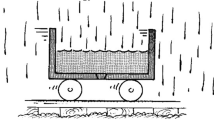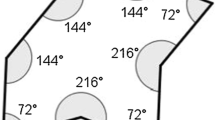Abstract
In the process of problem solving, intuitive thinking leads to findings that go beyond gaps and plays a decisive role in problem solving. Considering that problems often need to be solved in groups rather than by individuals, it is necessary to examine how intuitive thinking expressed by individuals is shared and elaborated among peers in a group setting. The purpose of this study is to investigate the characteristics of small groups when intuitive thinking emerges and is elaborated during problem solving. For this purpose, group discourse was observed among small groups of fifth and sixth grade primary students who were asked to solve a problem involving thermal phenomena. The findings show that intuitive thinking emerged gradually and was justified through interaction with logical thinking and empathy of group members. This emergence was made possible through the formation of a bond of empathy in the group. In addition, it was found that intuitive thinking is gradually elaborated through cycles of problem solving and that there are two types of elaboration: the connecting of things with little relevance and the discovering of detailed things. This elaboration could be explained by growth of tacit knowledge. Based on these results, we discuss the importance and meaning of intuitive thinking in the problem-solving process during group work.





Similar content being viewed by others
References
Brock, R. (2015). Intuition and insight: two concepts that illuminate the tacit in science education. Studies in Science Education, 51(2), 127–167.
Bruner, J. S. (1960). The process of education. New York: Harvard University Press.
Bruner, J. S. (1973). Beyond the information given: studies in the psychology of knowing. New York: Norton.
Chi, M. T., Feltovich, P. J., & Glaser, R. (1981). Categorization and representation of physics problems by experts and novices. Cognitive Science, 5(2), 121–152.
Chi, M. (2000). Self-explaining expository texts: the dual processes of generating inferences and repairing mental models. In R. Glaser (Ed.), Advances in instructional psychology (pp. 161–238). Mahwah: Lawrence Erlbaum Associates.
Clement, J. (2008). Creative model construction in scientists and students: the role of imagery, analogy, and mental simulation. Dordrecht: Springer Science & Business Media.
Clement, J., Brown, D. E., & Zietsman, A. (1989). Not all preconceptions are misconceptions: finding ‘anchoring conceptions’ for grounding instruction on students’ intuitions. International Journal of Science Education, 11(5), 554–565.
Crane, H. R. (1969). Problems for introductory physics. The Physics Teacher, 7(7), 371–378.
Creswell, J. W. (2013). Research design: qualitative, quantitative, and mixed methods approaches. Thousand Oaks: Sage publications.
Driver, R., Guesne, E., & Tiberghien, A. (1985). Children’s ideas in science. Philadelphia: Open University Press.
Eckstein, S. G., & Shemesh, M. (1989). Development of children’s ideas on motion: intuition vs. logical thinking. International Journal of Science Education, 11(3), 327–336.
Empathy. (n.d.). In Merriam-Webster.comOnline. Retrieved May 26, 2018, from https://www.merriam-webster.com/dictionary/empathy.
Ernst, G. W., & Newell, A. (1969). GPS: a case study in generality and problem solving. New York: Academic Press.
Fensham, P., & Marton, F. (1992). What has happened to intuition in science education? Research in Science Education, 22(1), 114–122.
Fischbein, E. (1987). Intuition in science and mathematics: an educational approach. Dordrecht: Kluwer Academic.
Gabel, D. L., Sherwood, R. D., & Enochs, L. (1984). Problem solving skills of high school chemistry students. Journal of Research in Science Teaching, 21(2), 221–233.
Hackney, H. (1978). The evolution of empathy. Personnel and Guidance Journal, 57, 14–18.
Hafner, R., & Stewart, J. (1995). Revising explanatory models to accommodate anomalous genetic phenomena: Problem solving in the “context of discovery.” Science Education, 79(2), 111–146.
Hogarth, R. M. (2001). Educating intuition. Chicago: University of Chicago Press.
Holton, G. J. (1998). The scientific imagination: with a new introduction. Harvard University Press.
Holyoak, K., & Morrison, R. (2013). Thinking and reasoning. In K. Holyoak & R. Morrison (Eds.), The Cambridge handbook of thinking and reasoning (pp. 1–9). Cambridge: Cambridge University Press.
Kahneman, D. (2003). A perspective on judgment and choice: mapping bounded rationality. American Psychologist, 58(9), 697–720.
Kim, H.-S. (2002). The Effect of reasoning by sensory experience on learning mechanics concepts (doctoral dissertation). In Seoul National University. Korea: Seoul.
Kösem, Ş. D., & Özdemir, Ö. F. (2014). The nature and role of thought experiments in solving conceptual physics problems. Science & Education, 23(4), 865–895.
Kushnir, T., Gopnik, A., Schulz, L., & Danks, D. (2003). Inferring hidden causes. In R. Alterman & D. Kirsh (Eds), Paper presented at the Proceedings of the Twenty-Fifth Annual Meeting of the Cognitive Science Society (pp. 699–703). Erlbaum. Retrieved from http://csjarchive.cogsci.rpi.edu/proceedings/2003/pdfs/141.pdf.
Lee, J. (2005). Intuition and construction in Kant. Philosophical Investigation, 17, 285–327.
Marton, F., Fensham, P., & Chaiklin, S. (1994). A Nobel’s eye view of scientific intuition: discussions with the Nobel prize-winners in physics, chemistry, and medicine (1970-86). International Journal of Science Education, 16(4), 457–473.
Medawar, P. B. (1969). Induction and intuition in scientific thought. London: Routledge.
Merriam, S. B. (1998). Qualitative research and case study applications in education. San Francisco: Jossey-Bass Publishers.
Ministry of Education (2009). The 2009 Revised Science Curriculum, Report No. 2011–361. Sejong: Ministry of Education.
Mortimer, E., & Scott, P. (2003). Meaning making in secondary science classrooms. Maidenhead. Philadelphia: Open University Press.
Na, J. (2014). The roles and features of everyday experience in elementary school students' understanding of thermal phenomena (doctoral dissertation). In Seoul National University, Seoul, Korea.
Nersessian, N. (1993). In the theoretician’s laboratory: thought experimenting as mental modeling. In D. Hull, M. Forbes, & K. Okruhlik (Eds.), In PSA: proceedings of the biennial meeting of the philosophy of science association (Vol. 2, pp. 291–301). East Lansing: Philosophy of Science Association.
OECD. (2013). PISA 2012 Assessment and Analytical Framework: Mathematics, Reading, Science, Problem Solving and Financial Literacy. OECD Publishing.
Oh, P. S. (2008). Comparison of hypotheses-formation processes between an earth scientist and undergraduate students: a case study about a typhoon’s anomalous path. Journal of the Korean Association for Research in Science Education, 28(6), 549–663.
Park, J.-Y. (2016). Problem solving. Seoul: Hakjisa.
Park, J., & Han, S. (2002). Using deductive reasoning to promote the change of students' conceptions about force and motion. International Journal of Science Education, 24(6), 593–609.
Park, J., & Song, J. (2017). The features of intuitive thinking emerged during problem solving activities about thermal phenomena: when intuitive thinking appears and how it is related to logical thinking. Journal of the Korean Association for Research in Science Education, 37(3), 535–549.
Piaget, J. (1971). The child’s conception of the world. London: Routledge & Kegan Paul Ltd..
Poincaré, H. (1907). The value of science (G. B. Halsted, Trans). New York: The Science Press. (Original work published 1905).
Poincaré, H. (1914). Science and method (F. Maitland, Trans). London, Edinburgh, Dublin, & New York: Thomas Nelson and Sons. (Original work published 1908).
Polanyi, M. (1958). Personal knowledge, towards a post critical epistemology. London: Routledge.
Polanyi, M. (1966). The tacit dimension. Chicago: University of Chicago press.
Polanyi, M. (1968). The creative imagination. Psychological Issues, 6(2), 53–91.
Polya, G. (1957). How to solve it: a new aspect of mathematical method. Princeton, NJ: Princeton university press.
Reiner, M. (1998). Thought experiments and collaborative learning in physics. International Journal of Science Education, 20(9), 1043–1058.
Root-Bernstein, R. S., & Root-Bernstein, M. M. (1999). Sparks of genius: the thirteen thinking tools of the world's most creative people. Boston, Mass: Houghton Mifflin Co.
Runco, M. A. (1994). Problem finding, problem solving, and creativity. Norwood, NJ: Ablex.
Runco, M. A., & Dow, G. (1999). Problem finding. In M. A. Runch & S. Pritzker (Eds.), Encyclopedia of creativity volume 2 (pp. 433–435). San Diego: Academic Press.
Salmon, W. (1967). The foundations of scientific inference: University of Pittsburgh pre.
Sandoval, W. A. (2015). Epistemic goals. In R. Gunstone (Ed.), Encyclopedia of science education (pp. 393–398). Dordrecht: Springer Science+Business Media.
Schwarz, N., & Skurnik, I. (2003). Feeling and thinking: implications for problem solving. In J. Davidson & R. J. Sternberg (Eds.), Thy psychology of problem solving (pp. 263–292). Cambridge: Cambridge University Press.
Scott, P. H., Mortimer, E. F., & Aguiar, O. G. (2006). The tension between authoritative and dialogic discourse: a fundamental characteristic of meaning making interactions in high school science lessons. Science Education, 90(4), 605–631.
Simon, H. A. (1978). Information-processing theory of human problem solving. In W. K. Estes (Ed.), Handbook of learning and cognitive processes (pp. 271–295). Hillsdale, NJ: Lawrence Erlbaum Association.
Sinclair, M., & Hamilton, A. (2014). Mapping group intuitions. In M. Sinclair (Ed.), Handbook of research methods on intuition (pp. 199–216). Cheltenham: Edward Elgar.
Smith, A. (2006). Cognitive empathy and emotional empathy in human behavior and evolution. The Psychological Record, 56(1), 3–21.
Sprod, T. (1997). Nobody really knows’: the structure and analysis of social constructivist whole class discussions. International Journal of Science Education, 19(8), 911–924.
Stavy, R., & Tirosh, D. (1996). Intuitive rules in science and mathematics: the case of ‘more of a more of B. International Journal of Science Education, 18(6), 653–667.
Tallant, J. (2013). Intuitions in physics. Synthese, 190(15), 2959–2980.
Tallant, J. (2014). Metaphysics, Intuitions and Physics. Ratio, 28(3), 286–301.
Webb, P., & Treagust, D. F. (2006). Using exploratory talk to enhance problem-solving and reasoning skills in grade-7 science classrooms. Research in Science Education, 36(4), 381–401.
Woolnough, B. E. (1989). Towards a holistic view of processes in science education. In J. Wellington (Ed.), Skills and processes in science education (pp. 115–134). London: Routledge.
Yerushalmi, E., & Eylon, B.-S. (2015). Problem solving in science learning. In R. Gunstone (Ed.), Encyclopedia of science education (pp. 786–790). Dordrecht: Springer Science+Business Media.
Acknowledgements
This study is the part of Ph.D. dissertation of Dr. Joonhyeong Park.
Funding
This research was supported by BrainKorea 21 PLUS project through the National Research Foundation of Korea (NRF) funded by the Ministry of Education (21B20151713505).
Author information
Authors and Affiliations
Corresponding author
Ethics declarations
Conflict of Interest
The authors declare that they have no conflict of interest.
Rights and permissions
About this article
Cite this article
Park, J., Song, J. How Is Intuitive Thinking Shared and Elaborated During Small-Group Problem-Solving Activities on Thermal Phenomena?. Res Sci Educ 50, 2363–2390 (2020). https://doi.org/10.1007/s11165-018-9784-x
Published:
Issue Date:
DOI: https://doi.org/10.1007/s11165-018-9784-x




